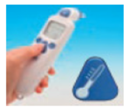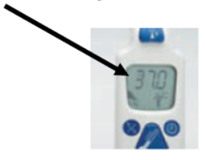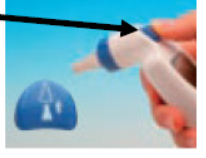Temperature management : tympanic temperature (PCCU)
exp date isn't null, but text field is
Objectives
Temperature measurement is a commonly used assessment parameter when caring for acutely and critically ill children. In the critically ill child an abnormal temperature may reflect changes in their physiological status. Therefore, temperature measurement and temperature trends must be accurate and consistent, as decisions about therapeutic intervention may be based upon it.
Pulmonary artery temperature measurement was considered to be the ‘gold standard’ for measuring core body temperature. However, in practice this is too invasive and not a practical method of thermometry. Instead, body temperature is usually measured from a site, or ‘shell’ sites that are thought to reflect the core temperature. The site and measuring device chosen is based upon a number of factors including age, clinical condition, degree of accuracy required, safety and ease of use. It is responsibility of the nurse to determine the best method for monitoring patient temperature and to use the temperature monitoring device correctly. Whichever site/equipment chosen, the nurse must be aware of the benefits and limitations of each.
This nursing procedural guideline is intended as a resource for nursing staff involved in caring for children in the Paediatric Critical Care Unit that require monitoring and measurement of body temperature. The guideline has been constructed after literature search and review of sourced textbooks, Medline and CINAHL, and external nurse expert peer review and opinion.
See also recommendations and further information at end of this guideline.
Scope
This nursing procedural guideline is intended to be followed by nurses involved in caring for the highly dependent or critically ill infant or child requiring body temperature monitoring within the Paediatric Critical Care Unit at the Royal Hospital for Children, Glasgow.
Audience
All nursing staff involved in the measuring and monitoring of temperature in the Paediatric Critical Care unit should be familiar with this nursing procedural guideline.
- Ear Tympanic thermometer (e.g. Covidien Genius™ 2 or Genius™ 3)
- Appropriate size probes
- Disposable probe covers
- Disposable apron
- Non-sterile gloves
Staff that have not used tympanic thermometry before are advised to check any manufacturer operating instructions and relevant training before first use. Genius™2 training information and presentation is available at: https://www.cardinalhealth.com/content/dam/corp/web/documents/patient-recovery/Literature/genius-2-tympanic-thermometer-tips-techniques-sheet.pdf
Genius™3 information is available at: https://www.youtube.com/watch?v=jEjNrYLmI4Q

Covidien Genius™3
|
Procedure |
Rationale |
|
Provide age appropriate explanation of procedure |
To ensure the child (and parent) understand and consent to the procedure. |
|
Wash hands thoroughly with appropriate skin cleanser and don disposable apron and gloves. |
To minimise the risk of cross infection. |
|
Choose tympanic temperature measurement device required and document which type chosen (E.g. Covidien Genius™ 2 or 3) Where possible use same type of equipment and same ear each time. Document if infant or child in heated environment (E.g. incubator) |
To ensure consistency in temperature readings. Switching between sites and changing from one type of thermometer to another can produce misleading results. There may be differing measurements if temperature measured in exposed or non-exposed ear or if in a superheated environment. Anatomical differences between the two ears can result in a difference of up to 1◦C. |
|
Remove thermometer from base unit and check probe lens and tip is clean, intact and clear of any material.
The probe tip may be wiped before use using dry lint free swab or lens wipe. If soiled, an Isopropyl wipe may be used. (Covidien 2014). N.B. Allow to dry prior to use. |
If lens is cracked or dirty then it may result in an inaccurate reading.
The thermometer lens must be free from fingerprints and/or smudges for proper operation. |
|
Push the probe tip firmly into a new disposable cover contained in a cassette in the thermometer base unit. (For Genius™ 2 or 3) Dashes will appear on the thermometer screen indicating mode. Ensure probe cover is correctly fitted on the probe tip, with no holes, tears or wrinkles on the plastic cover |
The disposable probe cover protects the tip of the thermometer probe and is needed for the unit to function correctly. A disposable thermometer tip cover can help minimise the risk of cross infection.
This indicates the thermometer has performed a system reset and is ready to use If probe cover is not fit correctly or holes evident, temperature readings can be inaccurate. |
|
Visually inspect infant/child’s ear canal to ensure clean and dry. Note general direction of ear. Use a gentle ear tug by pulling the pinna down and back in infants and small children, and up and back for older children.
Gently place the probe tip in the outer third of the ear canal and seal the opening, ensuring a snug fit. |
For an accurate reading it is vital that the tympanic membrane is ‘visualised’ by the thermometer tip. The gentle ‘ear tug’ can help align the thermometer probe toward the tympanic membrane.
This prevents ambient air interfering with the temperature reading and causing a false low temperature measurement. |
|
Ensure the thermometer is 'set' to correct mode according to the individual manufacturers' instructions (e.g. LCD screen displays 'Ear' and ◦C). |
An inappropriate mode setting may not give an accurate reading. |
|
Press and release triangular SCAN button.
Ensure thermometer stays in situ until reading appears and thermometer ‘beeps’. Once thermometer triple bleeps, remove thermometer probe tip from ear. The patient temperature and probe eject icons will be displayed.
|
This commences the thermometer scanning.
Movement of the thermometer and probe may interfere with its ability to ‘visualise’ the tympanic membrane or risk exposing the probe to the ambient air and can interfere temperature recording. |
|
The disposable probe tip cover can be ejected by pressing eject button, and then discarded. |
|
|
The nurse should now read and document the child's temperature and site - i.e. tympanic. |
|
|
The thermometer should now be returned to the base unit for storage. Note - The Genius™ 2 goes into sleep mode after 30-40 seconds of non-use. If the nurse has not had time to note temperature, it can be recalled by pressing and holding the ◦C button. |
Storing the thermometer in the base unit keeps it safe from damage and allows it to return to sleep mode. Sleep mode conserves function and optimises battery life. |
The blood supply of the tympanic membrane from the common carotid artery is shared with the hypothalamus. As the ear canal and tympanic membrane have no inherent metabolic activity, then the temperature of the tympanic membrane should be primarily determined by this blood supply. This means that the tympanic membrane temperature should in theory closely represent the hypothalamic temperature. As such, it is easy to understand why a number of studies find the tympanic thermometer can be a more accurate reflection of core temperature and a more accurate indicator of fever.
The tympanic thermometer uses infrared light to detect thermal radiation. Temperature is measured by inserting the probe into the auditory canal. The thermometer probe then scans and after a few seconds records the amount of infrared energy emitted by the tympanic membrane.
The tympanic or aural route has become popular in paediatrics and, provided correct technique has been used, it has a number of advantages over other methods of thermometry. Advantages include it being a more accurate reflection of core temperature, it is non-invasive, is quick and relatively easy to use and is comfortable for the child. Other advantages of tympanic or aural thermometry are that the procedure itself is more hygienic, less invasive and safer than other forms of thermometry.
Despite the increasing widespread use of tympanic or aural thermometry in paediatrics it is important that the nurse is aware that some studies have highlighted some limitations in its use. Some studies advise that tympanic thermometers should be used with extreme caution and only as an indication of temperature. For the tympanic thermometer to be more ‘accurate’, it must be placed in the ear canal correctly in order that it can ‘see’ the tympanic membrane. If the probe is not correctly placed this can result in the thermometer scanning the ear canal instead of the tympanic membrane and thus give a falsely low temperature reading. This can be more likely where there are multiple personnel taking temperatures.
Education of all staff using tympanic thermometers is essential to ensure reduction in user error and negative influence on temperature readings. Some studies have highlighted the fact that the ear canal in infants and children can be very different lengths, and as such the thermometer probes may be too large for smaller infants thus potentially influencing the accuracy of the temperature measurement.
Tympanic temperature readings may also be affected by the ambient temperature such as from incubators or may vary depending upon whether the ear used has been exposed to air or on a pillow or mattress.
There are conditions where tympanic thermometry may be contraindicated and these include the infant or child who has significant ear pathology, a foreign body in the ear or has moisture in the ear, such as cerebrospinal fluid or blood.
Remember that a tympanic thermometer must be cared for and stored correctly and some must be recalibrated every 12 months.
If the nurse finds any abnormal temperature measurements using the tympanic thermometer technique, then the nurse must recheck the temperature and also consider another method & site of thermometry. Any abnormality must be documented and reported to nurse-in-charge and doctor.
-
Bailey, J Rose, P (2001) Axillary and tympanic membrane temperature recording in the preterm neonate: a comparative study. Journal of Advanced Nursing, Vol. 34 (4), pp 465-474.
-
Bock, M Hohlfeld, U von Engeln, K Meier, P Motsch, J (2005) The accuracy of a new infrared ear thermometer in patients undergoing cardiac surgery. Canadian Journal of Anesthesia, Vol. 52 (10), pp 1083-1087.
-
Childs, C Harrison, R Hodkinson, C (1999) Tympanic membrane temperature as a measure of core temperature. Archives of Disease in Childhood, Vol. 80, pp 262-266.
-
Covidien (2009) GeniusTM2 Tympanic Thermometer and Base. Tips and Techniques Sheet.
-
Covidien (2012) GeniusTM2 Operating manual.
-
Covidien (2014) GeniusTM2 Tympanic Thermometer: Cleaning
-
Covidien (2018) Genius™3 Taking a temperature training presentation. (Youtube)
-
Dougherty, L, Lister, S (2004) Observations: Temperature. In: The Royal Marsden Hospital Manual of Clinical Nursing Procedures. (6th Ed). Blackwell Publishing, London.
-
El-Radhi, AS Patel, S (2006) An evaluation of tympanic thermometry in a paediatric emergency department. Emergency Medical Journal, Vol. 23, pp 4041.
-
Fisk, J Arcona, S (2001) Comparing tympanic membrane and pulmonary artery catheter temperatures. Dimensions of Critical Care Nursing, Vol. 20, pp. 24-34.
-
Fulbrook, P (1997) Core body temperature measurement: a comparison of axilla, tympanic membrane and pulmonary artery blood temperature. Intensive and Critical Care Nursing, Vol. 13, pp 266-272.
-
Gilbert, M Barton, AJ Counsell, CM (2002) Comparison of oral and tympanic temperatures in adult surgical patients. Applied Nursing Research, Vol. 15 (1), pp 42-47.
-
Guiliano, KK Scott, SS Elliot, S Guiliano, A (1999) Temperature measurement in crticially ill orally intubated adults: A comparison of pulmonary artery core, tympanic and oral methods. Critical Care Medicine, Vol. 27 (10), pp 2188-2193.
-
Leon, C Rodriguez, A Fernandez, A Flores, L (2005) Infrared ear thermometry in the critically ill patient. An alternative to axillary thermometry. Journal of Critical Care, Vol. 20, pp 106-110.
-
Loveys, AA Dutko-Fioravanti, I Eberly, SW Powell, KR (1999) Comparison of ear to rectal temperature measurements in infants and toddlers. Clinical Pediatrics, Vol. 38, pp 463-466.
-
Maxton, FJC Justin, L Gillies, D (2004) Estimating core temperature in infants and children after cardiac surgery: a comparison of six methods. Journal of Advanced Nursing, Vol. 45 (2), pp 214-222.
-
Moran, DS Mendal, L (2002) Core temperature measurement: Methods and current insights. Sports Medicine, Vol. 32 (14), pp 879-885.
-
NHS Greater Glasgow Prevention and Control of Infection Manual (2017) Core prevention policies
-
Pandey, A Ingrams, DR Jones, M Raman, R Marks, ND (2006) Reliability of a tympanic thermometer in measuring temperatures in children after minor ear surgery. The Journal of Laryngology and Otology, Vol. 120, pp. 375-377.
-
Purssell, E While, A Coomber, B (2009) Tympanic thermometry – normal temperature and reliability. Paediatric Nursing, Vol. 21 (6), pp. 40-43.
-
Pušnik, I van der Ham, E Drnovšek, J (2004) IR ear thermometers: what do they measure and how do they comply with the EU technical regulation? Physiological Measurement, Vol. 25, pp 699-708.
-
Robinson, JL Seal, RF Spady, DW Joffres, MR (1998) Comparison of esophageal, rectal, axillary, bladder, tympanic and pulmonary artery temperatures in children. The Journal of Pediatrics, Vol. 133 (4), pp 553-556.
-
Saxena, AK Topp, S Heinecke, A Willital, GH (2001) Application criteria for infrared ear thermometers in pediatric surgery. Technology and Health Care, Vol. 9, pp 281-285.
-
Sund-Levander, M Grodzinsky, E Loyd, D Wahren, LK (2004) Errors in body temperature assessment related to individual variation, measuring technique and equipment. International Journal of Nursing Practice, Vol. 10 (5), pp 216-223.
-
Van Staaij, BK Maroeska, M Rovers, AG Schilder, AWH (2003) Accuracy and feasibility of daily infrared tympanic membrane temperature measurements in the identification of fever in children. International Journal of Pediatric Otorhinolaryngology, Vol. 67, pp 1091- 1097.
Last reviewed: 09 May 2022
Next review: 09 May 2025
Author(s): Jeanette Grady
Approved By: PICU Guideline Group
Reviewer Name(s): L. Moore







